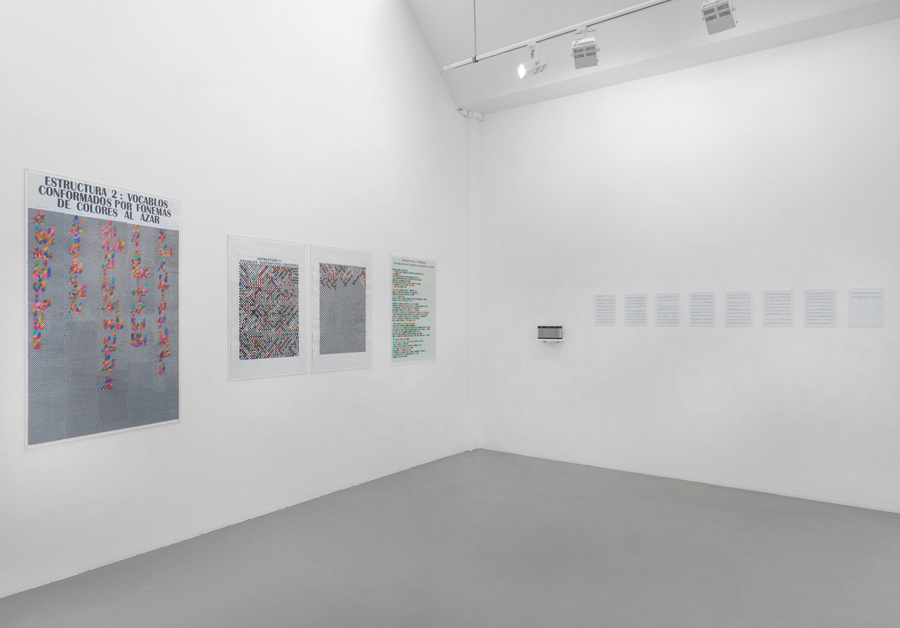Teresa Burga
Galerie Barbara Thumm, Berlin, Germany
Galerie Barbara Thumm, Berlin, Germany

A poem by Jorge Luis Borges, ‘La noche que en el Sur lo velaron’ (Night Death Watch on the Southside, 1929), provides the stimulus for Teresa Burga’s ‘Borges’ (1974-2017), an extensive series that occupies four walls of the Peruvian artist’s exhibition at Galerie Barbara Thumm: ‘Conceptual Installations of the ‘70s’. In an interview with the Argentinian writer Fernando Sorrentino, Borges noted that the poem describes the way in which ‘night frees us from one of the greatest sources of anguish: the tediousness of reality.’ It is within the darkness, he continues, that the city loses its details and takes on ‘the simplicity of a chart or a dream.’

Burga’s experimental drawings on graph paper and hand-ruled grids deconstruct ‘Night Death Watch on the Southside’ via visual analyses, in which phonemes and strophes are represented by coloured felt-tip bars and stacks that stand like urban topographies. The schematics are not directly labelled with the poem’s title; some could easily be the combinatorial word games workshopped by the French experimental literature group the Oulipo, like the home-drawn crosswords of Georges Perec. A recording of a haphazard refrain played on a woodwind instrument drifts through the space: a new transposition of the poem to musical score, produced in collaboration with Peruvian composer JD Malachowski, which evokes a line from its second stanza: ‘someone whistling alone in the world’.
A clue as to why Burga was so captivated by Borges’s poem can be found in the marginalia of her ‘Theater’ series (1974), a collection of cross-hatched and pointillist pencil drawings of the covers of periodicals, in which she records the dates and times at which she worked on each of the small pieces. Clocking in and out, Burga’s marks indicate that, like Borges, she frequently showed up for the late shift, working ‘under the power and integrity of night’.
The work that Burga produced during this period touches numerous histories of Latin American conceptualism. She was a member of the Arte Nuevo group from 1966 to 1968, which included the likes of Víctor Delfín and Gloria Gómez-Sánchez and is credited with having introduced pop and op art to Peru. She left to study at the Art Institute of Chicago, when a leftist military coup was in the process of restricting avant-garde activities in Peru. Upon returning to Lima after her studies, Burga found that a conceptual approach would allow her to filter social life and poetry into art within this controlling regime, without appearing overtly political. There are connections to be drawn here with the arte de sistemas (systems art) that at the same time was being produced at the Centro de Arte y Comunicación in Buenos Aires: a centre for experimental and new media art operating within a right-wing dictatorship, in which Argentinian artists sought to expand – and dissolve – art beyond its objects, in parallel with new technologies.

At the back of Galerie Barbara Thumm, the installation Obra que desaparece cuando el espectador trata de acercarse (propuesta III) (Work that disappears when the viewer tries to approach it, Proposal III, 1970-2017) embodies Burga’s early attempts at such a dissolution of art into experience. On the rear wall of a darkened room is a large grid of red, yellow and cyan light bulbs that click on and off in different combinations as the viewer draws near. To a contemporary audience, the electronic circuits and sensors controlling the light patterns could seem a little mechanical, perhaps crude, but the work’s warm glow is a prime example of the artist’s commitment to conceptual projects not as cold systems, but as a signalling of reality as a network of relations. To return to Borges’s night-walking poem, in Burga’s practice art becomes a translation of the ‘irrevocable rhythms that for him [or her] / composed the friendliness of the world.’
Main image: Teresa Burga, ‘Borges’, 1974-2017, 51 drawings, musical score and sound installation, pencil, black and coloured felt pen on paper, print on paper and sound file. Courtesy: the artist and Galerie Barbara Thumm; photograph: Jens Ziehe























